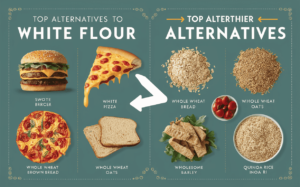In the realm of health and nutrition, the question of whether white flour is bad for health sparks significant debate. White flour, commonly known as ‘Plain flour’, ‘All-purpose flour’ or ‘Maida’, has become a staple in diets worldwide, particularly in forms such as bread, pizza, burgers, pasta and more. However, its impact on health is a topic worth delving into. It’s important to know why white flour is bad for us due to how much we eat it. Let’s explore the reasons behind the health concerns associated with white flour, identify common foods made from it, and find out detailed suggestions on how to avoid it, including the best alternatives.

It’s Missing the Good Stuff:
When wheat is turned into white flour, the parts that have all the vitamins, minerals, and fiber are taken out. This means that foods made with white flour are missing a lot of the nutrients that our bodies need. Bakers have gravitated towards white flour primarily because of its long-lasting quality, attributed to the presence of oil that prevents it from spoiling. Additionally, white flour is unappealing to rodents and insects due to its lack of nutritional value, further contributing to its popularity in baking circles. Even though some nutrients are added back into white flour, it’s still not as good as eating whole grains.
Changes in Wheat:
The way wheat is grown has changed a lot, and not all of these changes are good for our health. Changes in wheat hybridization over the last century to support agribusiness have raised concerns about the health effects of modern wheat. Some people find that even if they don’t have a problem with gluten, modern wheat can still make them feel not great.
The Health Impacts of White Flour:
White flour is derived from wheat that has been stripped of its germ and bran, leaving behind the endosperm. This process not only removes the grain’s natural brown color but also its nutritional value, including fiber, vitamins, and minerals. The result is a fine, easily digestible flour that has a longer shelf life but poses several health risks:
- Blood Sugar Levels: White flour has a high glycemic index (GI), meaning it can cause rapid spikes in blood sugar levels. Frequent consumption can lead to insulin resistance, a precursor to type 2 diabetes.
- Nutritional Deficiency: The refining process strips away essential nutrients. Regular consumption can lead to deficiencies in fiber, iron, and B vitamins.
- Digestive Issues: The lack of fiber in white flour can lead to digestive problems, including constipation and an increased risk of colon cancer.
- Weight Gain: Foods made from white flour are often high in calories but low in satiety, leading to overeating and weight gain. Eating a lot of white flour can make your blood sugar go up and down very quickly. This can make you feel tired, hungry again soon after eating, and over time, can lead to weight gain. Because white flour is in a lot of junk food, it’s easy to eat too much of it without realizing.
Common Culprits in Our Diet
Many everyday foods are made from white flour, making it a hidden staple in our diets:
- Breads and Pastries: Including white bread, bagels, croissants, sandwiches, wraps and muffins.
- Pasta: Traditional pasta is typically made from white flour.
- Snacks: Crackers, biscuits, and many other packaged snacks are white flour-based.
- Baked Goods: Cakes, cookies, and pies usually contain white flour.
How to avoid White Flour: Strategies and Alternatives
Avoiding white flour requires mindfulness about food choices and a willingness to explore healthier alternatives. Here’s how you can start:
- Read Labels Carefully: Opt for products that list whole grains as the first ingredient and avoid those with “enriched flour” or “wheat flour” (which are just euphemisms for white flour).
- Choose Whole Grains: Incorporate whole grains like whole wheat, oats, barley, and quinoa into your diet. They are nutritious and high in fiber.
- Experiment with Flour Alternatives: Explore flours made from almonds, coconut, chickpeas, or other legumes and nuts. These flours are not only healthier but also offer unique flavors and textures to your dishes.
- Homemade is Best: When possible, prepare meals and snacks at home. Homemade food allows you to control the ingredients and opt for healthier alternatives.

Top Alternatives to White Flour Foods:
- Whole Wheat Bread and Pasta: These are readily available and offer a much higher nutritional profile than their white counterparts.
- Almond Flour Baked Goods: Almond flour is low in carbs and high in nutrients, making it an excellent alternative for baking.
- Quinoa or Brown Rice: Use these as alternatives to traditional pasta or white rice. They provide more fiber and nutrients.
- Vegetable Noodles: Spiralized vegetables like zucchini or sweet potatoes can be a fun and nutritious alternative to pasta.
Wrapping Up:
Despite the widespread use of white flour in our diets, it is important to acknowledge its negative impact on health. By recognizing the dangers of consuming white flour and seeking out healthier options, we can make informed decisions that will positively impact our well-being in the future. Moving away from white flour is a crucial move towards a more wholesome diet and a healthier way of living.
